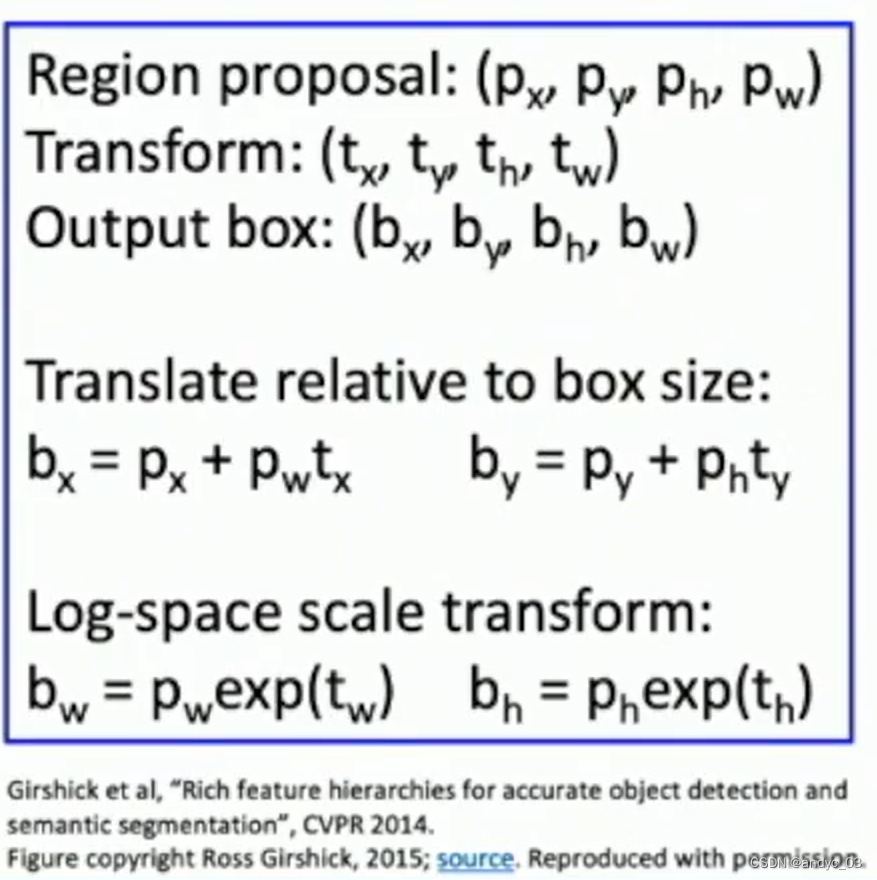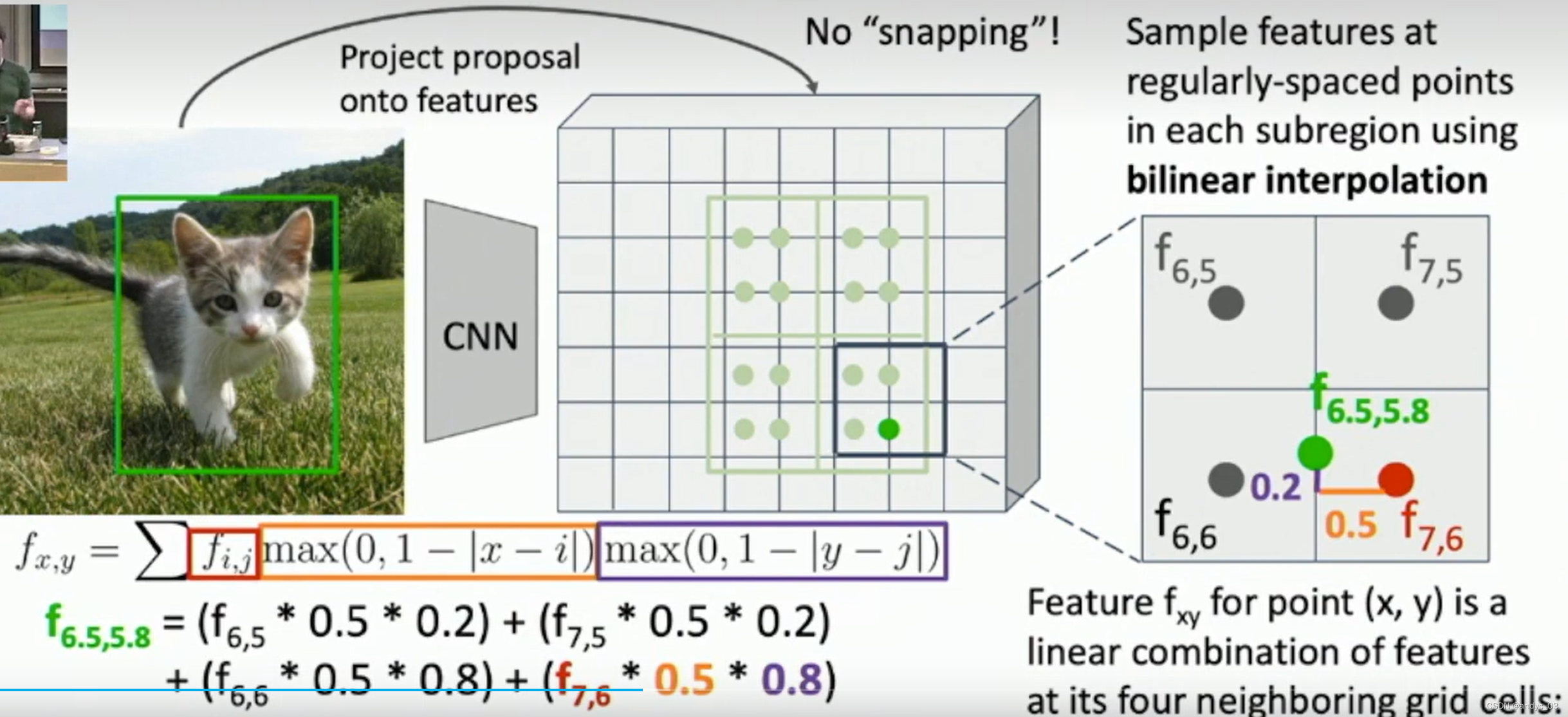Object Detection
Output:
- category label from fixed, known set of categories
- bounding box (x, y, width, height)
If only one object is needed to be detected -> add FC layer to the Net pretrianed on ImageNet
Sliding Window
apply a CNN to many different crops of the image, CNN classifies each crop as object / backgroud
but too many windows!! and may detect repeatedly
we need region proposals to find a small set of boxes that are likely to cover all the objects
“Selective Search” quick to generate 2000 regions
R-CNN : Region-Based CNN
- Region proposals
- warped the image to fixed size 224*224
- forward each region through ConvNet independently
- output a classification score and also a Bbox of 4 numbers, using the following algorithm

Measurement of boxes (IoU)
I o U = Area of Intersection Area of Union IoU = \frac{\text{Area of Intersection}}{\text{Area of Union}} IoU=Area of UnionArea of Intersection
I o U > 0.5 IoU > 0.5 IoU>0.5 is decent
I o U > 0.7 IoU > 0.7 IoU>0.7 pretty good
I o U > 0.9 IoU > 0.9 IoU>0.9 perfect
Overlapping Boxes: Non-Max Suppression (NMS)
- select next highest-scoring box
- eliminate lower-scoring boxes with IoU>0.7 (with the box we selected in step1)
- If any boxes remain goto 1
Evaluating Object Detectors: mAP(Mean Average Precision)
run detector on all test images + NMS
for each category, computer AP = area under precision vs Recall Curve
1. for each detection (high -> low) 1. If it matches some GT(Ground-Truth) box with IoU>0.5 mark it as positive and eliminate the GT 2. otherwise mark is as nagative 3. plot a point on PR curve 2. AP = area under PR CurvemAP = average of AP for each category
COCO mAP: compute mAP for each IoU threshold and take average
How to get AP = 1.0 -> hit all GT boxes with IoU > 0.5, no false positive ranked above any true positive
Fast R-CNN
- ConvNet (Backbone network)-> convolutional features for entire high resolution image
- Regions of Interest (Rols)
- Crop + Resize features
- Per-Region Network (light-weight -> fast)
- output category and box
Cropping Features: Rol Pool
- project proposal onto features
- snap to gird cells
- divide into 2*2 gird of (roughly) equal subregions
- max-pool within each subregions
- output the region features (always the same size even if we have different sizes of input regions)
Rol Align
Rol Align -> better align to avoid snapping

Faster R-CNN
Insert Region Proposal Network (RPN) to predict proposals from features
after the backbone network -> RPN -> regional proposals
Imagine an anchor box of fixed size at each point in the feature map
At each point predict whether the corresponding anchor contains an object
for positive boxes, also predict a box transform to regress from anchor box to object box
Use k different anchor boxes at each point

Single stage Faster R-CNN
just use anchor to make classification and object boxes predictions
Semantic Segmentation: Fully Convolutional Network
Input -> Convolutions -> Scores C * H * W -> argmax H * W
use cross-entropy loss of every pixel to train the network
Trick: Downsampling and Upsampling
Downsampling : Pooling, strided convolution
Upsampling
Unpooling
Bed of nails : fill 0
Nearest Neighbour: same numbers in small blocks
Bilinear Interpolation
f x , y = ∑ i , j f i , j max ( 0 , 1 − ∣ x − i ∣ ) max ( 0 , 1 − ∣ y − j ∣ ) f_{x,y} = \sum_{i,j}{f_{i,j} \max(0, 1-|x-i|) \max(0,1-|y-j|)} fx,y=∑i,jfi,jmax(0,1−∣x−i∣)max(0,1−∣y−j∣)
i,j in Nearest neighbours
Use two closest neighbours in x and y to construct linear approximations
Bicubic Interpolation
three closest neighbours in x and y to construct cubic approximation
Max Unpooling
Learnable Upsampling
Mask R-CNN
Just add Conv layers to predict a mask for each of C classes on the region proposals
Panoptic Segmentation
speperate different objects in the same category
Human Keypoints
Represent the pose of a human by locating a set of keypoints
Joint Instance Segmentation and Pose Estimation
-> General Idea: Add Per-Region “Heads” to Faster / Mask R-CNN
Dense captioning -> nlp -> visual reasoning
3D shape prediction …





